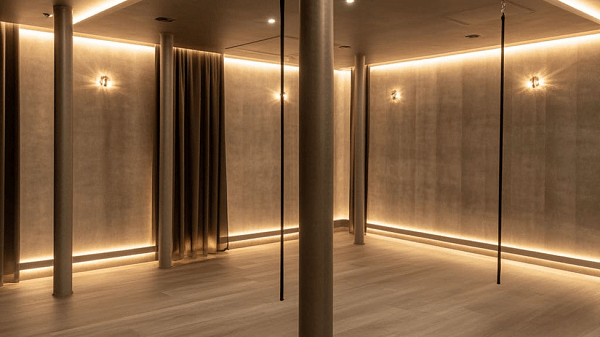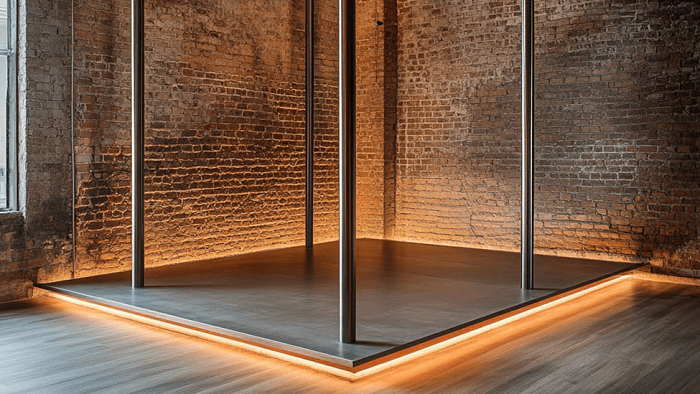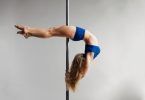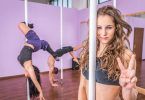Aerial and pole dancing have surged in popularity over the past decade, evolving from niche activities into mainstream fitness and artistic practices. The physicality and grace required in these disciplines demand an environment that not only supports but enhances the performance. The design of a studio plays a crucial role in creating such an environment, providing the foundation for a safe, functional, and inspiring space. This guide delves into the key elements of designing an aerial and pole dancing studio, exploring every aspect from layout and lighting to material choices and safety considerations. Whether you are a studio owner, designer, or dancer, understanding these elements will allow you to create or enhance a space that truly serves its purpose.
The design images in this article are sourced from https://fancyhouse-design.com/, highlighting expert design elements in aerial and pole dancing studios.
Layout and Space Planning for an Aerial Pole Studio
When it comes to aerial and pole dancing studios, space planning is paramount. An open layout is essential, providing the necessary room for free movement and practice without obstacles. The first consideration is ensuring that the space is large enough to accommodate multiple dancers at once, without them feeling cramped. This involves not only floor space but also vertical space, which is often overlooked. High ceilings are non-negotiable in such studios; they provide the essential vertical clearance needed for aerial routines that involve silks, hoops, and other apparatuses. Without adequate height, the risk of injury increases, and the effectiveness of practice diminishes.
The proportions of the room must be carefully considered. A studio that is too narrow can feel restrictive, while one that is too wide may lead to inefficiencies in heating, cooling, and lighting. A well-balanced room will offer enough space for equipment like poles and aerial rigs, while still leaving ample room for movement. Additionally, the layout should allow for unobstructed views of the mirrors and any instructors present, ensuring that dancers can easily monitor their form and technique.

Wall Treatments for the Perfect Aerial Pole Studio Atmosphere
The walls of an aerial and pole dancing studio do much more than define the space—they play a key role in the room’s functionality and atmosphere. Textured wall panels are an excellent choice for these studios, offering both aesthetic appeal and practical benefits. Panels with a subtle wood grain or a soft matte finish can add warmth to the room without drawing too much attention. These textures provide a visual counterbalance to the sleek, polished surfaces of the poles and floors, creating a more inviting and balanced environment.
Mirrors are another essential element, but they must be used thoughtfully. Floor-to-ceiling mirrors should be installed on at least one wall, ideally opposite the main light source to maximize brightness and enhance the sense of space. These mirrors are invaluable for dancers, allowing them to observe their movements in real time and make immediate adjustments. However, care must be taken to ensure the mirrors are high-quality and securely installed to prevent any accidents.
In addition to mirrors, acoustic panels should be integrated into the wall design. These panels, often made from sound-absorbing materials, help to manage the acoustics of the space, reducing echoes and ensuring that music and instructions can be heard. Vertical panels that contrast in color or texture with the rest of the wall can also add a decorative element, further enhancing the studio’s design while serving a practical purpose.

Flooring Choices for Aerial Pole Studios
The choice of flooring in an aerial and pole dancing studio is crucial, as it directly impacts the safety, comfort, and performance of the dancers. The flooring must be durable enough to withstand the repeated impacts of dance routines, yet soft enough to cushion falls and reduce strain on the body. Wide-plank wood flooring is a popular choice, offering a natural, warm feel that contrasts nicely with the industrial elements often found in such studios. The wood’s grain provides a subtle texture underfoot, enhancing grip while maintaining a smooth surface for fluid movement.
Polished concrete is another option, particularly in studios with an industrial aesthetic. Its hardness and durability are unmatched, making it ideal for heavy use. However, it can be unforgiving, so adding cushioned mats or specialized underlays in key areas—like around poles or under aerial rigs—can provide the necessary protection without compromising the design.
Vinyl or rubber flooring offers a balance between durability and comfort. These materials can mimic the appearance of wood or stone while providing a softer, more resilient surface. They are also easy to clean and maintain, making them practical for high-traffic areas. The flooring should complement the rest of the studio’s design, blending seamlessly with the walls and ceiling while providing a safe and comfortable surface for dancing.

Ceiling Design and Lighting
The ceiling in an aerial and pole dancing studio serves both functional and aesthetic purposes. Exposed ductwork, steel beams, and other industrial elements are often embraced as part of the design, contributing to the space’s overall aesthetic. These elements, when painted in dark, matte colors like charcoal or black, can create a striking contrast with lighter walls and floors, adding depth and character to the space.
Lighting is perhaps one of the most important aspects of the studio’s design. Recessed lighting is ideal for such spaces, as it provides even illumination without the harsh glare of overhead fixtures. These lights can be strategically placed to highlight key areas, such as the poles or mirrors, ensuring that dancers have clear visibility at all times. Track lighting offers additional flexibility, allowing the direction and intensity of the light to be adjusted based on the needs of the dancers. For instance, brighter lighting may be required during practice sessions, while softer lighting could be used during performances or cool-down periods.
Ambient lighting, such as LED strips integrated into the walls or under platforms, adds a layer of sophistication and comfort to the space. This type of lighting creates a warm, inviting glow that enhances the overall atmosphere without being overwhelming. It also helps to define the space, particularly in larger studios, by adding depth and dimension to the room.
Apparatus Installation
The installation of poles and aerial equipment must be done with precision and care, as these elements are central to the functionality of the studio. Poles should be made from high-quality materials like chrome or stainless steel, which offer both strength and a smooth surface for gripping. The poles must be securely anchored to both the floor and ceiling to ensure they can withstand the significant forces applied during use. It’s also important to consider the spacing between poles, ensuring that dancers have enough room to perform without colliding with one another.
Aerial equipment, such as silks, hammocks, and hoops, requires careful consideration of ceiling height and rigging points. These items should be installed by professionals with experience in aerial arts, ensuring that all rigging points are secure and capable of supporting the weight and movements of the dancers. The rigging hardware should be discreetly integrated into the ceiling design, maintaining the room’s clean and uncluttered appearance. Additionally, the equipment should be easily adjustable to accommodate dancers of different heights and skill levels.
Furniture and Seating
While the primary focus of an aerial and pole dancing studio is on movement, the inclusion of thoughtfully designed seating can enhance the functionality and comfort of the space. Low, round cushions made from durable, high-quality fabric provide a comfortable resting place for dancers between sessions. These cushions should be arranged in a way that encourages social interaction and community building, such as in a circular formation in the center of the room.
Platforms, particularly those used for pole dancing, can also double as seating or staging areas. These platforms should be sturdy and well-cushioned to ensure safety, and they should be integrated seamlessly into the room’s design. The use of platforms adds a layer of depth to the studio, creating distinct areas for different activities and enhancing the overall layout.

Windows and Natural Light
Natural light is a powerful tool in any studio design, and aerial and pole dancing studios are no exception. Large, floor-to-ceiling windows are ideal, as they allow for ample daylight to enter the space, creating a bright and uplifting environment. The connection to the outdoors provided by these windows can also enhance the mood of the dancers, making the studio feel less confined and more open.
However, it’s important to manage the amount of light entering the studio to avoid glare and overheating. Blackout curtains, made from heavy, high-quality fabric, offer a practical solution. These curtains can be drawn across the windows when needed, allowing for complete control over the lighting conditions. The fabric and color of the curtains should match the overall aesthetic of the studio, contributing to the room’s visual coherence even when they are not in use.
Color Palette and Material Choices
The color palette of an aerial and pole dancing studio plays a significant role in setting the tone of the space. A monochrome or neutral palette, consisting of shades of gray, black, and white, creates a sophisticated and calming atmosphere that encourages focus and concentration. These colors can be layered in different textures and finishes, such as matte walls, polished poles, and textured flooring, to add depth and interest without overwhelming the senses.
Material choices are equally important. The combination of natural materials like wood with industrial elements like metal creates a balanced and harmonious environment. Textures should be chosen to complement one another, with smooth surfaces juxtaposed against rougher ones to create a dynamic visual experience. The materials used should be high-quality and durable, capable of withstanding the rigors of daily use while maintaining their appearance over time.

Safety and Practical Considerations
Safety is paramount in any aerial and pole dancing studio, and the design must reflect this priority. The installation of poles and aerial equipment should be handled by professionals to ensure that all elements are secure and capable of supporting the demands of the activities. Regular maintenance and inspections are essential to identify any potential issues before they become safety hazards.
Flooring should be chosen not only for its aesthetic appeal but also for its ability to absorb impact and prevent slips. Adding cushioned mats in key areas, such as under poles or around platforms, can provide additional protection without detracting from the overall design. Lighting should be carefully planned to ensure that the room is well-lit at all times, reducing the risk of accidents caused by poor visibility.
Conclusion
In designing an aerial and pole dancing studio, every element must be carefully considered to create a space that is both functional and beautiful. From the layout and ceiling height to the choice of materials and color palette, each decision contributes to the overall success of the studio. By focusing on the needs of the dancers and prioritizing safety and comfort, you can create a space that inspires movement and creativity, providing a perfect environment for both practice and performance.







